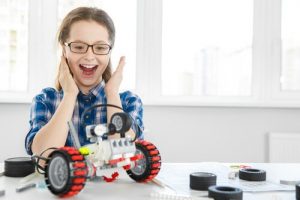Understanding the Brains of Gifted Children

There are different social prototypes of beliefs about gifted children.
How do the brains of gifted children work?
By age 6, the brains of gifted children are considered to have the same intelligence quotient (IQ) as a person who is 30 or older. At the same time, their brains usually work faster.
Some studies suggest that the cerebral cortex of gifted children grows much more slowly than that of typical children. This means that the cerebral cortex of a gift child will reach its maximum weight by age 11, rather than by age 6.
The brains of gifted children grow during a more prolonged period of time. However, the physical processes that influence the brain of a gifted child still remain a mystery.
“By age 6, the brains of gifted children are considered to have the same intelligence quotient (IQ) as a person who is 30”
Important considerations about gifted children
Certain studies have shown that the neurons of gifted children have a greater number of connections in the areas of memory and problem solving.

Other studies attribute intelligence to genetics. Therefore, a gifted child may very well have relatives that are also gifted.
Some theorists establish a specific IQ level in order to define giftedness, assuming that intelligence has to do with this number. However, a person’s intelligence quotient isn’t everything. It’s also important to recognize that intelligent or precocious children aren’t the same thing as gifted children.
How can I know if my child is gifted?
As we already mentioned, intelligence isn’t the only factor to take into consideration when identifying giftedness in children. Often, the following factors also come into play: creativity, persistence and motivation.
Main characteristics of gifted children
Knowing if your child is gifted isn’t always easy, even for parents. Upon observation, parents can perceive certain signs that distinguish their children as gifted:
- They are very creative and very original. This not only applies to things like drawing and painting, etc, but also to play, ideas and methods.
- These children have an extensive vocabulary. Their first phrases appear when other children of the same age can hardly pronounce words.
- Gifted children possess prodigious memories, meaning they have a high capacity for remembering what they learn.
- They have a great ability to pay attention and concentrate very easily.
- These children tend to be very restless. As a result, giftedness is often confused as ADHD – attention deficit hyperactivity disorder. However, the problem is that gifted children often find class time to be extremely slow and boring. Their learning moves at a much faster pace.
- Gifted children are drawn to social and moral issues at an early age. They are sensitive to inequality and injustice. They worry about war, pollution, domestic violence and other social issues.
- They are often very empathetic.

Specific recommendations to keep in mind
It’s important to point out the importance of providing sufficient stimulation for the brains of gifted children. If not, their brains may not come to develop enough, and their giftedness may not even be noticeable.
In short, there is no exact formula for detecting if your child is gifted or not. In fact, even experts on the subject are uncertain about what specifically occurs in the brains of gifted children.
“Gifted children often find class time to be extremely slow and boring. Their learning moves at a much faster pace”
At the same time, the characteristics that appear above aren’t the only factors that determine whether a child is gifted or not. It’s important for parents to reach out to professionals if they suspect their child may be gifted.
All of that being said, there is only one thing that is certain: Gifted children require all of the love, support and understanding that their parents can give them. That way, parents can help their children enjoy a happy childhood.
All cited sources were thoroughly reviewed by our team to ensure their quality, reliability, currency, and validity. The bibliography of this article was considered reliable and of academic or scientific accuracy.
- Barragán, M. C. (2009). Identificación del alumnado con altas capacidades intelectuales. Revista Digital Innovación y Experiencias Educativas, 25, 1-15.
- Gálvez, J. M. (2000). Alumnos precoces, superdotados y de altas capacidades. Ministerio de Educación.
- Sánchez, C. (2006). Principales modelos de superdotación y talentos. Universidad de Murcia, Departamento de Métodos de Investigación y Diagnóstico en Educación, España.
- Sastre-Riba, S. (2008). Niños con altas capacidades y su funcionamiento cognitivo diferencial. Rev Neurol, 41(Supl 1), S11-6. http://www.carei.es/archivos_materiales/AACC.pdf
- Tourón, J. & Reyero, M. (2001). La identificación de alumnos de alta capacidad. Bordón, 54 (2), 311-338.
This text is provided for informational purposes only and does not replace consultation with a professional. If in doubt, consult your specialist.








